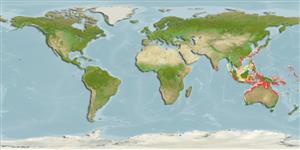Environment: milieu / climate zone / depth range / distribution range
Écologie
marin démersal; profondeur 20 - 50 m (Ref. 90102). Tropical
Indo-West Pacific: Australia, Indonesia and the Philippines.
Taille / Poids / Âge
Maturity: Lm ? range ? - ? cm
Max length : 10.0 cm TL mâle / non sexé; (Ref. 90102)
Description synthétique
Morphologie | Morphométrie
Épines dorsales (Total): 5; Rayons mous dorsaux (Total): 20-24; Épines anales 1; Rayons mous anaux: 16 - 20. Edges of scales of upper two-fifths of body dark brown, the centres pale. Upper part of body with 8 V-shaped dark bars faintly visible, becoming darker at the lower part of each V. A row of large dark brown spots on lower side of body. Two prominent oval black spots, one above the other, basally in caudal fin. Posterior margin of preopercle and opercle strongly serrate. Cheek scales ctenoid. Body elongate, its depth 5.7 to 6.9 SL (Ref 42740).
Found on open sand or muddy bottoms with small reef or debris outcrops (Ref. 48636). Mainly known from trawls in depths over 35 m (Ref. 48636). Found near reefs in open mud bottoms at depths of 20-50 m (Ref. 90102).
Life cycle and mating behavior
Maturité | Reproduction | Frai | Œufs | Fécondité | Larves
Allen, G.R., 1997. The marine fishes of tropical Australia and south-east Asia. Western Australian Museum, Perth, Western Australia. 292 p. (Ref. 36661)
Statut dans la liste rouge de l'IUCN (Ref. 130435)
Menace pour l'homme
Harmless
Utilisations par l'homme
Plus d'informations
Noms communsSynonymesMétabolismePrédateursÉcotoxicologieReproductionMaturitéFraiRassemblement de ponteFéconditéŒufsDéveloppement de l'œuf
Taille/ÂgeCroissanceLongueur-poidsLongueur-longueurFréquences de longueursMorphométrieMorphologieLarvesDynamique des populations larvairesRecrutementAbondanceBRUVS
RéférencesAquacultureProfil d'aquacultureSouchesGénétiqueElectrophoresesHéritabilitéPathologiesTraitementNutrientsMass conversion
CollaborateursImagesStamps, Coins Misc.SonsCiguateraVitesseType de nageSurface branchialeOtolithesCerveauxVision
Outils
Articles particuliers
Télécharger en XML
Sources Internet
Estimates based on models
Preferred temperature (Ref.
123201): 23.3 - 28.5, mean 27 °C (based on 107 cells).
Phylogenetic diversity index (Ref.
82804): PD
50 = 0.5000 [Uniqueness, from 0.5 = low to 2.0 = high].
Bayesian length-weight: a=0.00692 (0.00311 - 0.01538), b=3.06 (2.88 - 3.24), in cm total length, based on LWR estimates for this Genus-body shape (Ref.
93245).
Niveau trophique (Ref.
69278): 3.4 ±0.4 se; based on size and trophs of closest relatives
Résilience (Ref.
120179): Haut, temps minimum de doublement de population inférieur à 15 mois (Preliminary K or Fecundity.).
Fishing Vulnerability (Ref.
59153): Low vulnerability (10 of 100).
